|
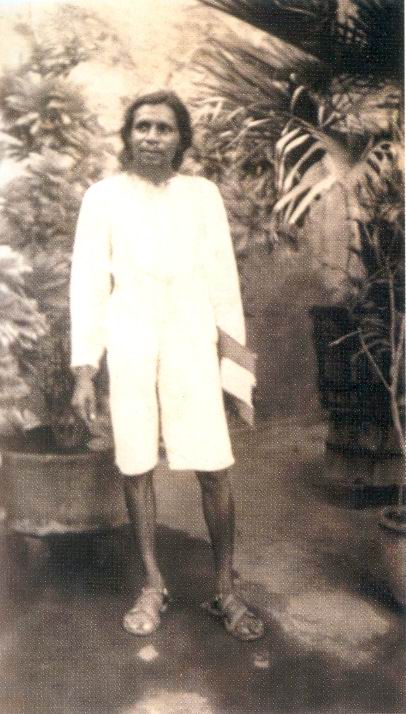
Chandulal
Ashram engineer of Golconde |
Chandulal, who was then the chief engineer, was the
most devoted worker of all; his life was dedicated to
the service of the Mother. He ate only the Ashram
food, slept on a mat and pillow on a bed, dressed
always in shorts and Ashram sandals, and had no
other hobbies than the Building Service. The Mother
had great confidence in him. Yet he had never had
any experience with reinforced concrete, or with
such a big building as Golconde. His junior engineer,
Jatindranath Bal, who came a little later, knew much
more in this field.
- Mrityunjoy -
"Golconde, was something of a 'do-it-yourself project.
I found myself not only the designer, but something of
a general contractor," said George Nakashima, who
along with Franticek Sammer had been sent by Antonin
Raymond to build Golconde. He worked in close
collaboration with Chandulal, the Ashram engineer. It
was the first high-strength reinforced concrete building
in India.
|
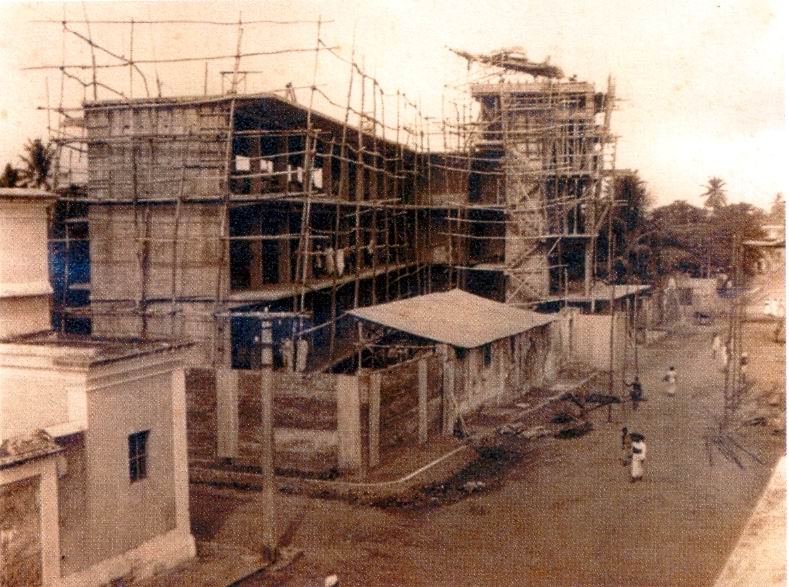
Golconde
construction North-East View - 1940 |
|
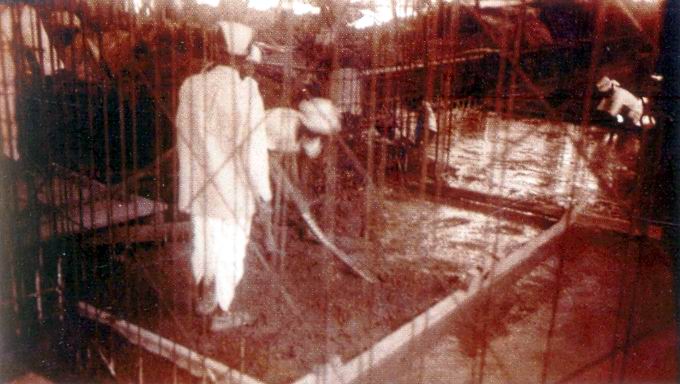
Golconde construction-25th Nov. 1940 Cement vibrator |
Normally, in reinforced concrete work where large areas are cast in form work, when the form
work is, removed, the faces of the cast areas are plastered over and made level and smooth. But
for this work at Golconde, Francois insisted that the surfaces be left as they were, after the form
work was removed and only smoothed over with a carborundam stone. In this way, the quality
of the work could be seen and so the work had to be done very carefully, there should be no
holes, no blank spaces and this was done by having the concrete vibrated at the time of casting.
This was quite a new technique to us. The details of the form work could be seen, the joints of
the planks, the screw heads and even the grain of the wooden planks. All this was part of the
aesthetic detail in the architecture and those who visit Golconde are impressed by it.
The other example was in the use of the wooden planks for the staircase hand-rails. Francois
insisted that the planks should be left with all the defects in them, defects which all planks have
and which are normally covered over. These small defects add to the beauty of the wood and
show its intrinsic value.
Udar- |
Page - 19
|
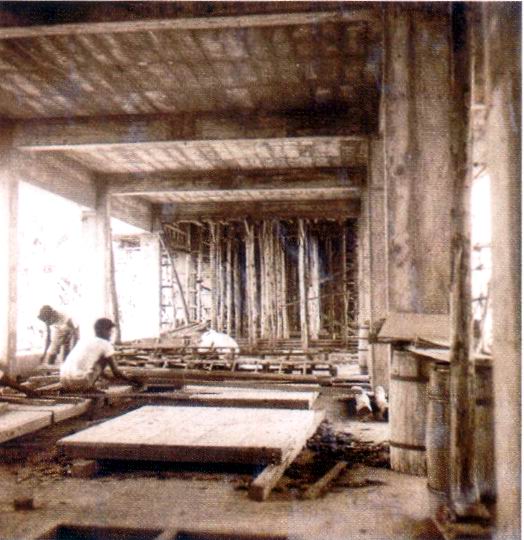
Golconde workers preparing shuttering for laying concrete |
Sanjivan recounted later to some of his art students and to a few friends something interesting. He had told
them that the Mother had instructed them to choose only the 'living pebbles' for the concreting work - and
that is what they did.
It required a supreme boldness on the part of the Mother to push through her idea, knowing very well the
limited and obscure conditions in which it had to be worked out - through an inexperienced engineer, a
handful of assistants with little or no technical training, and a few unskilled labourers who had never even
seen a reinforced concrete building, let alone worked on constructing one.
- Mrityunjoy -
The purpose of the dormitory was not primarily the housing of the disciples: it was the creating of an activity,
the materialisation of an idea, by which the disciples might learn, might experience, might develop, through
contact with the erection of a fine building... On the job perfect order was maintained. Among the various
disciples chosen to work on the building, this one engrossed in the business of testing the soil might have been
a retired dentist, that one responsible for the opening and closing the gate - he actually had been a banker -
did his job with a conscientiousness impossible to obtain in a world where a man listens for the sound of the
five o'clock whistle."
- Antonin Raymond -
|
|
All nails used for the frames for concreting would be straightened, counted and
used again. Hundreds of nails were required every day. The store was maintained with
scrupulous care, where every nail was counted.
- Antonin Raymond -
|
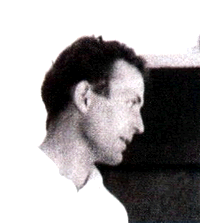
Franticek Sammer Czechoslovakian architect and artist |
The lines of the building were so beautifully designed, with the roof
made of large curved cement-concrete tiles, that the whole is truly
a masterpiece of architecture. Mr. Raymond brought with him his
team of architects, consisting of George Nakashima, a Japanese, and
Franticek (Francois) Sammer, a Czechoslovakian. George Nakashima
made the first drawings of Golconde and even made a model of a
room. Work was started on 10th October 1937.1 had the very happy
opportunity of working with Francois and learning so much from
him. He was a perfectionist and, very much in the manner of the
Mother, believed in 'perfection in detail'. The perfection of the work
done at Golconde added to the fame of this building.
-Udar- |
|
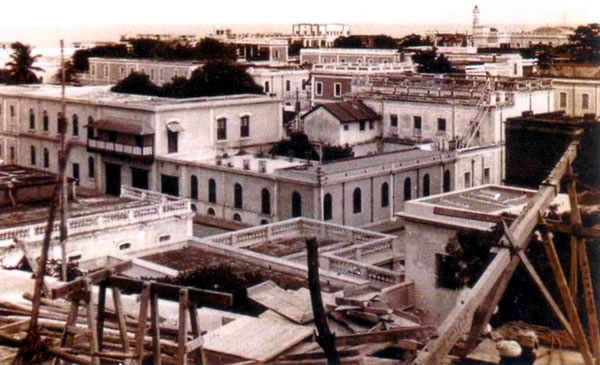
Golconde construction View
from Golconde roof. |
Page - 20
|
In every single thing, Francois insisted on the utmost perfection and to me
this was a wonderful training and such a great help in my own sadhana. I
informed the Mother about all this and she was very pleased with this way
of working.
- Udar-
During the concreting days we had to be on the site more than twelve
hours a day. Instead of six months, it took about six years to finish the
concreting; it ended somewhere towards the end of 1945. (Meanwhile, by
the end of 1942 all the three architects had left, due to the deterioration in
the international situation.)
- Mrityunjoy - |
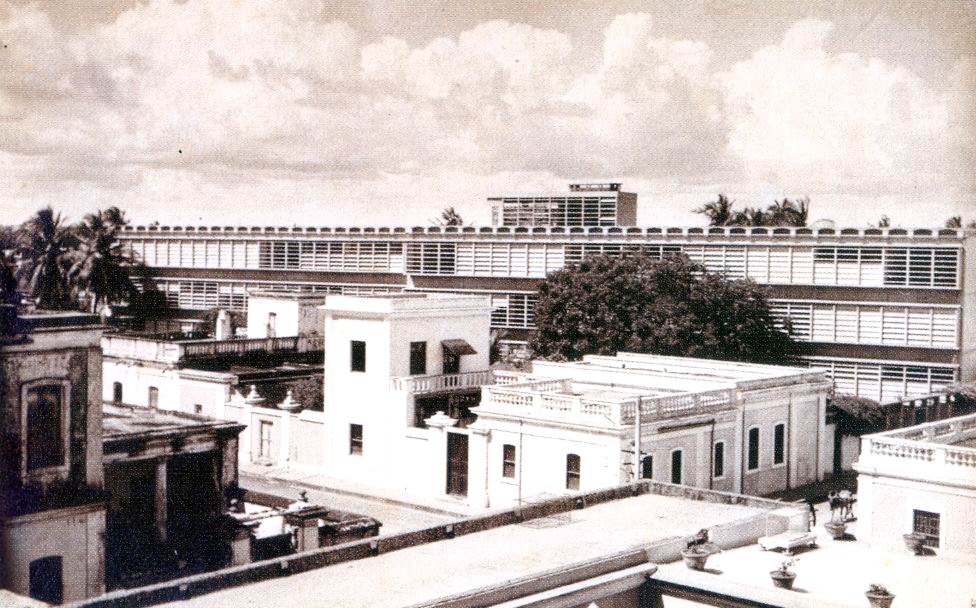
View of Goconde from the Ashram terrace - 1948 |
|
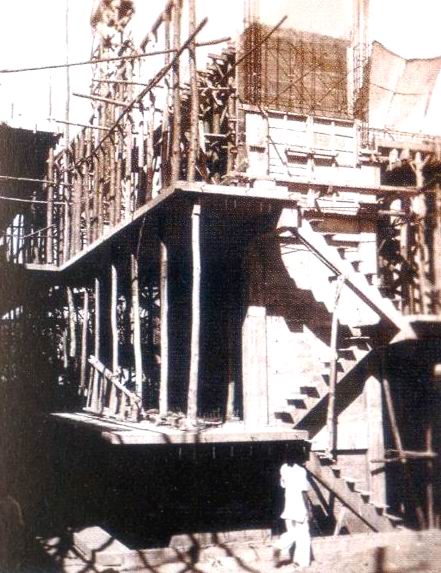
Golconde construction Back stairs, East view Shanti in front |
As many sadhaks as possible were pressed into service there; to anyone young or old asking for work, part time,
whole time, the Mother's one cry was: "Go to Golconde, go to Golconde." It was one of Mother's daily topics
with Sri Aurobindo who was kept informed of the difficulties, troubles innumerable, and at the same time, of
the need of his force to surmount them. Particularly when rain threatened to impede or spoil some important
part of the work, she would invoke his special help; when for instance, the roof was to be built. How often
we heard her praying to Sri Aurobindo: "Lord, there should be no rain now." Menacing clouds had mustered; strong, stormy west winds blowing ominously; rain imminent; and torrential Pondicherry rain! We would look
at the sky and speculate on the result of the fight between the Divine Force and the natural force. The Divine
Force would of course win: slowly the Fury would leash her forces and withdraw into the cave. But as soon as
the intended object was achieved, a deluge swept down as if in revenge... During the roof construction, work
had to go on all night long and the Mother would mobilise and marshal all the available Ashram hands and put
them there. With what cheer and ardour our youth jumped into the fray at the call of the Mother, using often
Sri Aurobindo's name to put more love and zeal into the strenuous enterprise...
And that is how this beautiful structure could be realised on the physical plane.
- Nirodbaran -
(Twelve Years with Sri Aurobindo) |
Page - 21
|
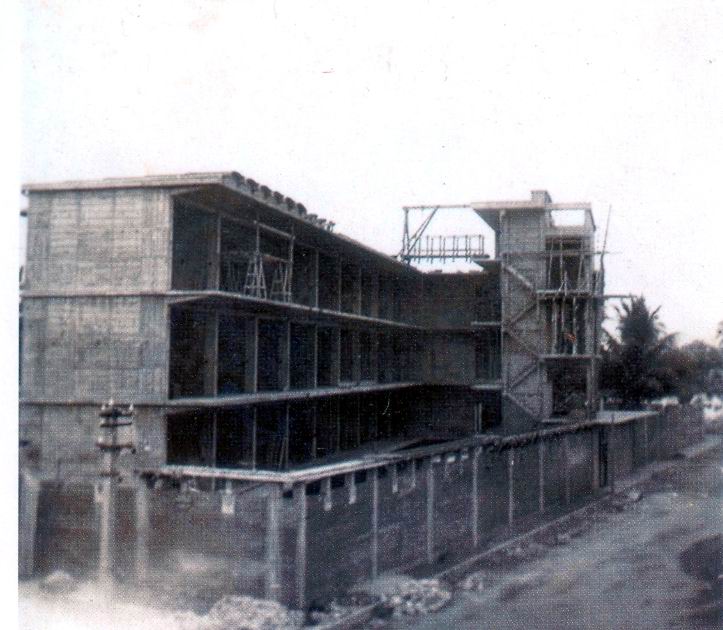
Golconde construction - 1942 |
Udar was closely connected with the Golconde work
from the very beginning. The main concreting work of Golconde was over somewhere
towards the end of 1945. Still a lot of work for completing the building such as
fixing of the louvre blades, the doors, the other fittings, completing the floor
etc. were remaining. This work was taken up by Udar and his team of workers.
Golconde is built in three parts: East, West and middle portion. Little gaps are
left in between these parts which are covered with copper plates. This is to
avoid cracks due to heat. Golconde is also earthquake proof and is provided with
lightning conductors. As soon as this building was ready, the Mother appointed
Mona as the overall in-charge of Golconde. Due to pressure of visitors during
the World War 11, this building which was to be a dormitory to house special
sadhaks for their sadhana, was obliged to be opened to visitors, even before it
was fully completed.
- Mrityunjoy - |
Why the name 'Golconde'? To set up such a large building required quite a lot of money and, in
those days, much money was not available. So the Mother spoke to Sir Akbar Hydari about it, and
as he was the Dewan to the Nizam of Hyderabad he was able to get from the Nizam a donation
of one lakh of rupees for this building through the Finance Department which was under Raja
Shamraj. Today, one lakh does not seem much, but in those days it was indeed
quite
a large sum, as its buying- power was over twenty times what it is now, especially at Pondicherry where things were remarkably cheap. A ton of cement, good Japanese cement, cost only around Rs. 25/- and steel about Rs. 200/- per ton. Pondicherry was then a free port and there were absolutely no Customs or Import duties or restrictions. And as we had then a good off-
loading pier, shipments from Japan could come directly to Pondicherry. Hence with this large sum of money the building work was taken up. Now because the first money came from Hyderabad, the Mother wanted to give a name to the building which had some connection with Hyderabad and so she chose the name Golconde, the French rendering of
Golconda, the famous diamond mine in Hyderabad.
- Udar- |
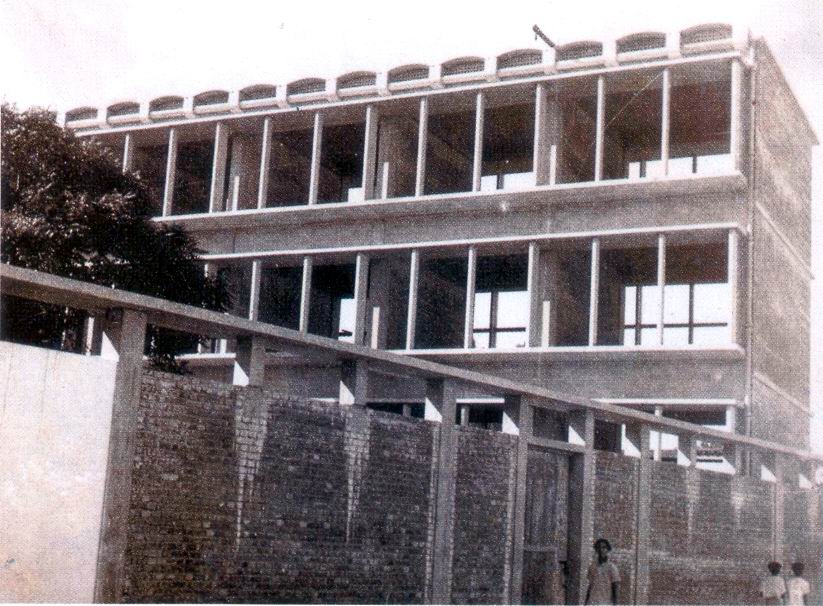
Golconde
construction south-East view - June 1942 |
In the catalogue, 'Festival of India', Golconde is singled out as 'the finest example of
modern functional architecture built in India in the pre-lndependence period.'
- Charles Correa -
(an outstanding Indian architect)
Page - 22
|
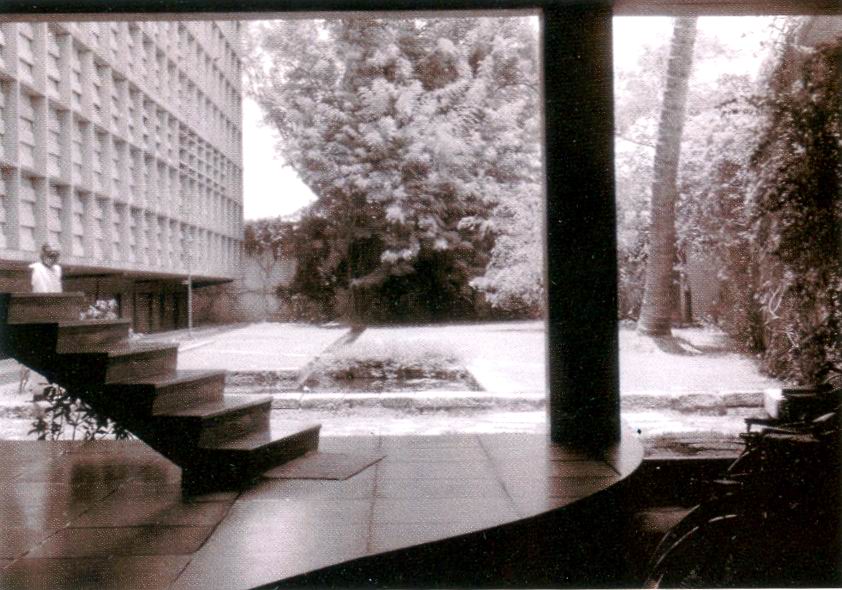
Golconde - piano top and stairs view of the front garden |
The floor is a layered limestone found in several
places in India. Here in the South it is known as Cuddapah Stone, as it comes
from that district. It has been used for ages - but not as we have done in
Golconde: highly polished, and with the sides cut by machine to a very
straightedge. As the machines to do this were not available here at that time, I
had to design and make our own machines at as low a cost as possible. The
architects had specified that the floor slabs should be laid 'butt-jointed' - as
is done with glazed tiles in bathrooms and so on. But for such large slabs, this
meant very high-precision edge-cutting, which my machine could not manage. So
Sammer, who was the architect in charge, and truly an artist, said that they
should be laid with wide joints. This was done, and the result is much more
beautiful than a butt-joint would have been.
This is how Mother works.
She has often created difficulties so that in overcoming them we arrive at a
much truer and more beautiful result.
- Udar-
|
|
The Mother asked us to drill an artesian tube-well, and she indicated
where it had to be done. When we were drilling this well, generally clay
and sand were extracted; but once some black material came up, which
was quite intriguing. As I then had free access to Sri Aurobindo, I took a
handful of this stuff to show it to him and he asked me what it was. I said
that it looked to me like half-formed coal. On hearing this, Sri Aurobindo
smiled sweetly and said, "Ah then! You want to pull down Golconde and
have a coal mine there?" It was truly wonderful to hear him joke. One
would, perhaps, expect such a Mahayogi to be serious, but he was always
ready with a joke and a smile. He once said that one could be serious
about a few small things, but about the rest, one should always laugh
at them. Years later we learnt that this black stuff was lignite and that it
stretches over a wide area, stretching well-beyond a hundred kilometers.
In fact lignite is mined at Neyveli and is used for power generation.
- Udar-
|
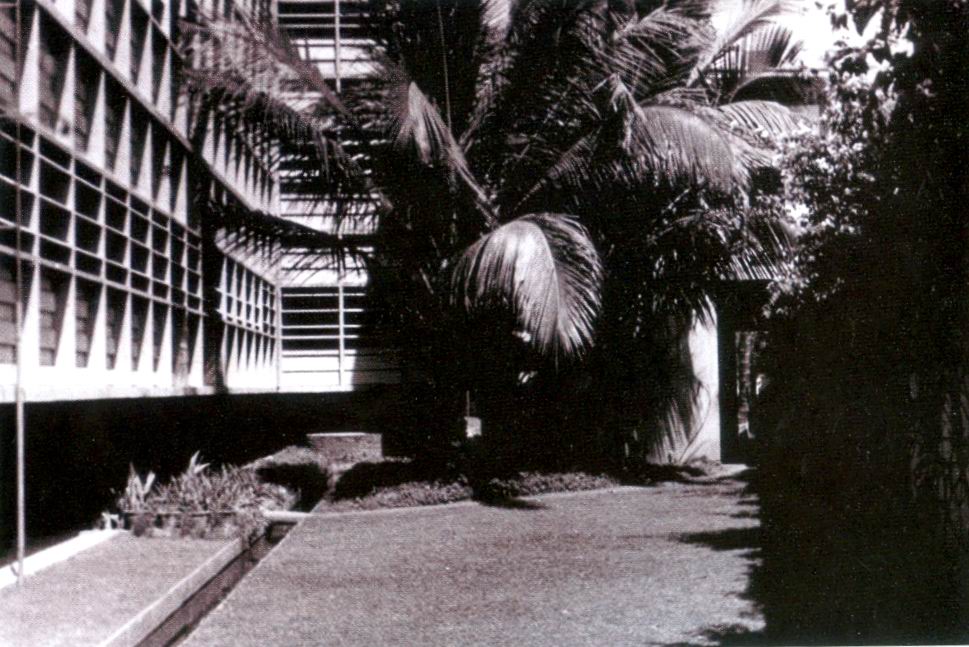
Golconde side view with artesian well |
Page - 23
|
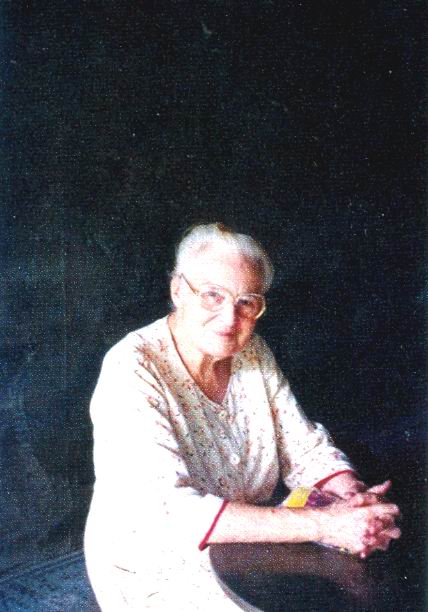
Mona of Golconde |
"... As regards Golconde and its rules - they are not imposed
elsewhere - there is a reason for them and they are not
imposed for nothing. In Golconde Mother has worked out her
own idea through Raymond, Sammer and others. First Mother
believes in beauty as a part of spirituality and divine living; Secondly she believes that physical things have the Divine
Consciousness underlying them as much as living things; and
thirdly that they have an individuality of their own and ought
to be properly treated, used in the right way, not misused or
improperly handled or hurt or neglected so that they perish
soon or lose their full beauty or value;..."
25th February 1945
an excerpt from a letter of Sri Aurobindo
There is a nice story about how the Mother chose Mona to
manage Golconde:
Mona was a model housekeeper. Datta (Miss Dorothy
Hodgson), a sadhika, once visited her. She was very much
impressed by her spotless house. When the Mother was looking
for someone to look after Golconde, Datta told her, "I have
been to Mona Pinto's house. She keeps her home spotlessly
clean. She may be the one to look after Golconde."
- Mrityunjoy - |
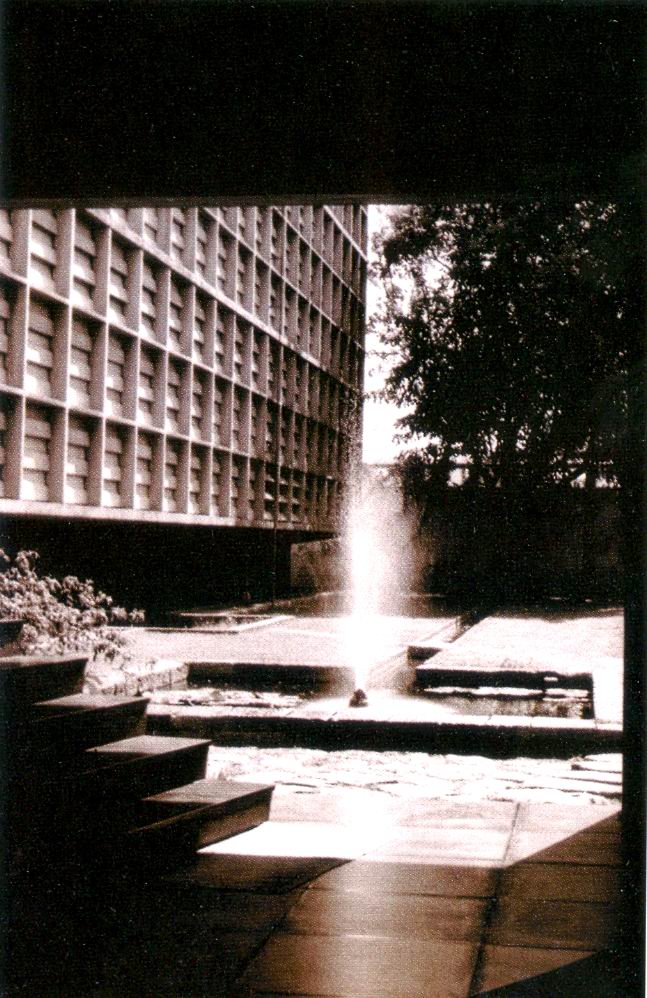
Golconde fountain |
|
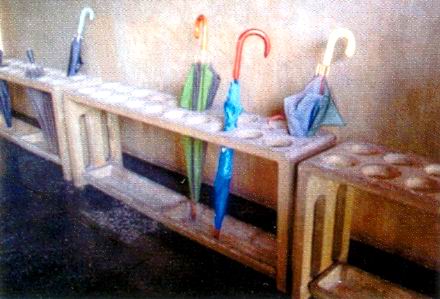
Umberlla stand in concrete designed and made by Udar |
Golconde, today, a guest house of the Ashram, was not
originally intended for that purpose. The Mother wanted a big
building to lodge some of her sincere and serious disciples.
But circumstances changed that. Golconde turned into a guest
house long before it was completed, during the middle of the
Second World War when visitors began to pour in and many
people wanted to settle in Pondicherry with their families to be under the protection of the Mother and Sri Aurobindo. The Mother reluctantly permitted it, and once started it
continued until the building was completed after the war. Then the Mother put Mona in charge, an English lady with
a hospitable heart and an excellent organising capacity. The maintenance and orderliness of Golconde under her
personal supervision and hard work has gained a great reputation at home and abroad.
- Mrityunjoy -
|
Page - 24
|
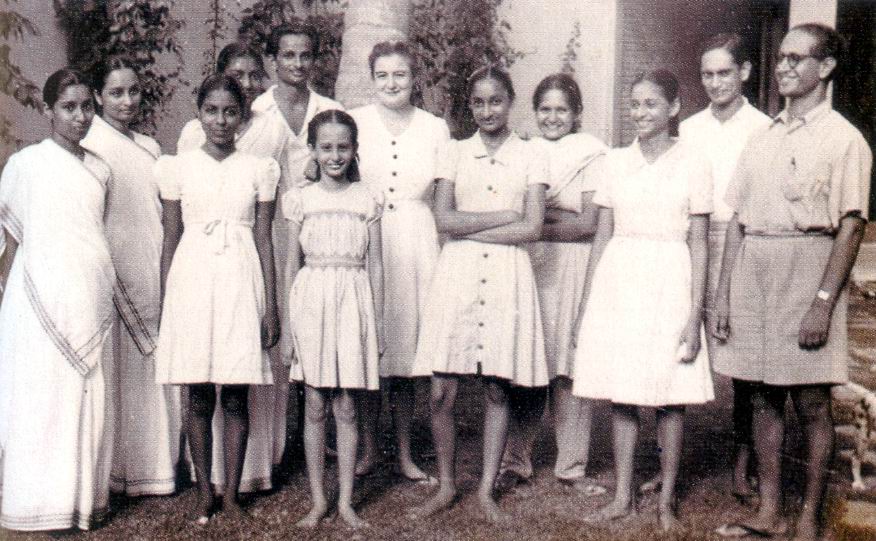
The Golconde team Maniben, Kusum, Lilou, Pushpa, Chandrakant, Gauri,
Mona, Mridula, Millie, Wilfy, Udar |
Here is an interesting comment by the Mother: "Mona's birthday is on the eleventh.
She was born on the eleventh day of the eleventh month of 1911. Eleven - that is
the number of progress... she is someone who truly loves to do things well, and
wants to do them well and whatever she does, she does lovingly and very well."
- Mrityunjoy -
Each room was provided with a set of furniture of simple beauty made out of
Burma teak, with the inside of the cupboard drawers made of red cedar. The
furniture was designed by Sammer, one of the architects of Golconde, and was
manufactured by Udar.
- Mrityunjoy -
"In the afternoons after the servants left I remember Mona and myself cleaning the
toilet bowls which had yellow marks due to water stagnating. We two would also
do gardening when necessary."
- Maniben - |
|

Golconde
staff in the 1940's 1st row: gardeners and gardener's boys
2nd row:Shivalingam, Mona, Kusum, Kumud, Maniben, Gauri, Lilou,
Pushpa, Mridula, Udar
Back row: Maids, gate-keeper |
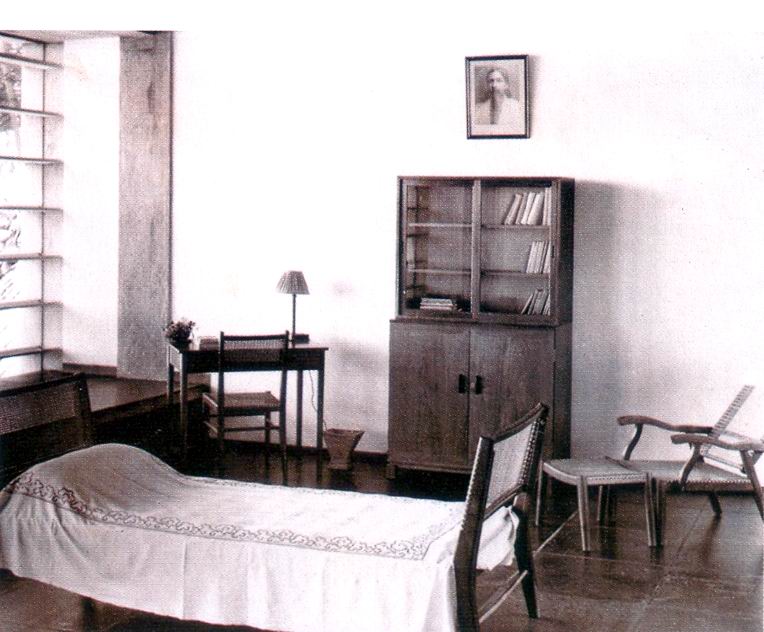
Golconde room with funiture |
Page - 25
|
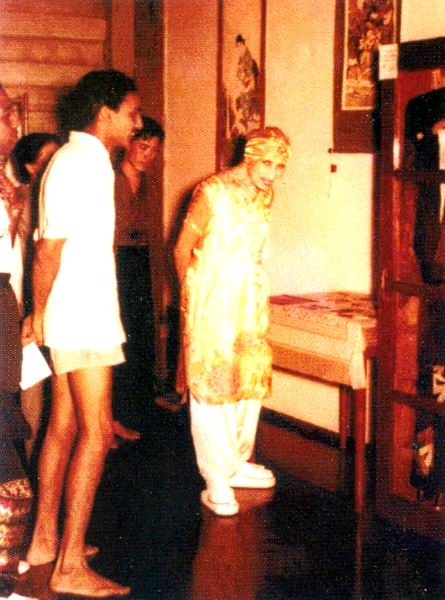
The Mother at the Japanese exhibition Amyio, Gautam -15th
Aug. 1955 |
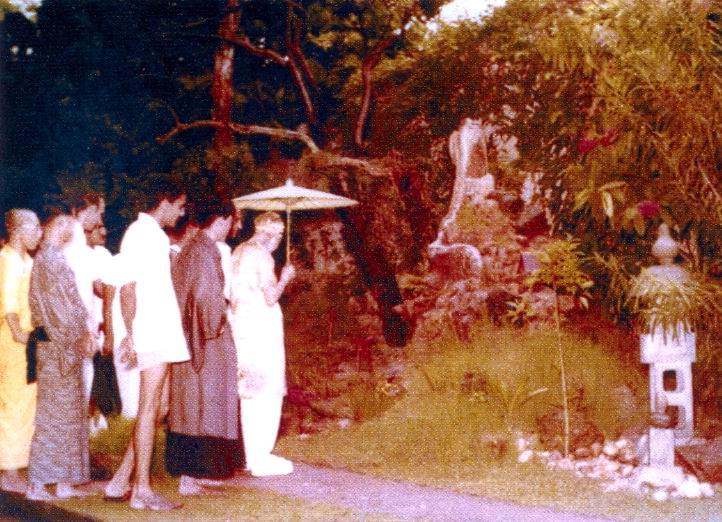
The Mother looking at the Japanese garden at the back of Golconde
Pavitra, Gautam, Udar |
It was a joy to step into the laundry. It was
well designed, always neat, clean and well maintained. All the washing was done
by hand, and the jobs ere distributed: there were soapers, washers, rinsers.
On sloping cement benches the servants sat scrubbing the already soaped clothes.
Soaping was done by one worker and supplied to four scrubber, each o them with
their own seat and our basins or rinsing- first in hot water in one basin and
them three times in cold water."
-Kusum- |
I really don't know how many years it took, but it went on
and I had very fine workers. I can't say I had any kind of
genius but everything came from the Mother. I couldn't do
it myself, I know that. I look back and I see that I was not a
very great engineer but I tell you, if somebody is asked to
solve any big problem and he comes to Mother, you can't
imagine how She can solve problems.
- Udar-
|

The Mother with the Japanese group 15th Aug. 1955 |
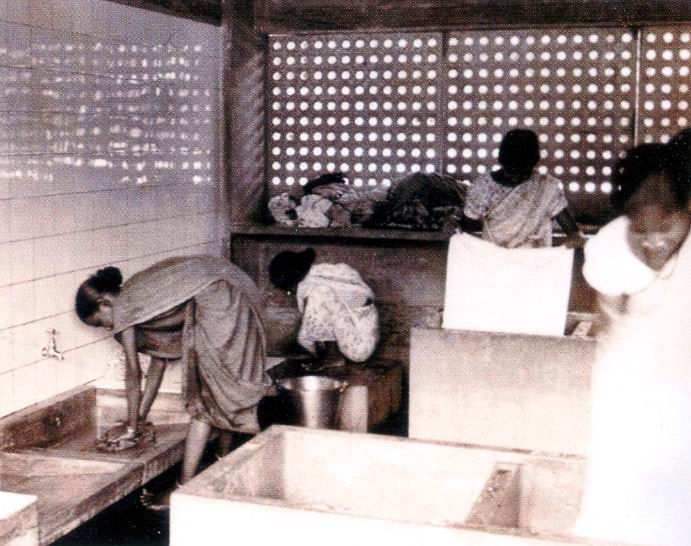
Maids hand-washing clothes |
Page - 26
|
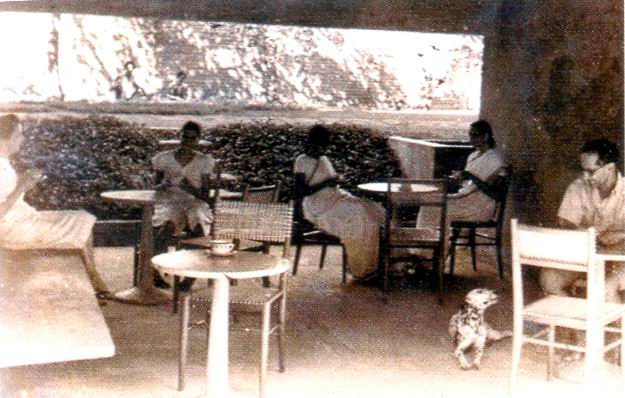
Golconde tea basement in the 40s Mona, Mridula, Maniben, Kusum, Udar,
Beauty |
About the tea at Golconde: When we were working there we were so engrossed in our work that we
did not even think of taking a tea-break. But the Mother, in Her marvellous sweetness, though She
Herself did not drink tea, knew our habits and our preferences, so She asked Mona to see that we got
tea at 3:00 p.m. every day. This was the start of the Golconde tea time.
-Udar-
Afternoon teas at Golconde were filled with stories
that brought me insights into life with Mother as only
Udar could recount them.
- Nancy -
|
|
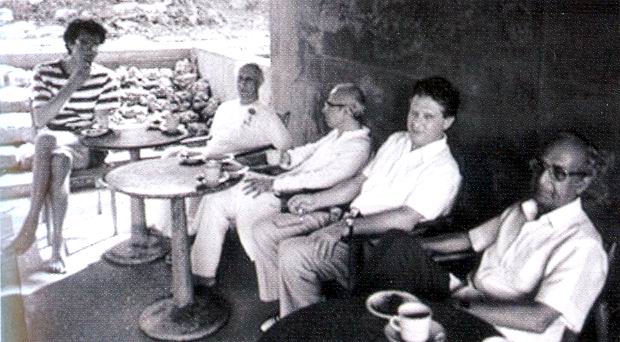
Golconde tea basement Bob, Udar, Sudarshan Nagpal, Eckhard, Mahender sud |
When the regular playground groups were formed
Mother used to encourage even the ladies to join the
group. When I went to ask the Mother if I could join
the group, She asked me, "Have you got the time?" I
was quite disappointed and told Mother, "Yes, Mother,
my work is over by 5 p.m. and the Playground groups
start at 5.30 p.m." Then She told me that I could join
the Playground group activities. But by 1958 I had to
leave the group as there was so much work the whole
day and I was getting tired by the evening. I wrote to
the Mother that I would like to leave the group, the
Mother said, "Yes, you leave the group and rest in the
evening."
- Maniben
|
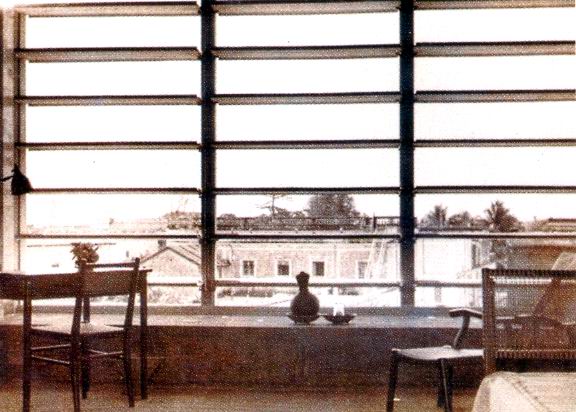
Golconde room interior, louvres opened
|
|
My visit this time for the Darshan of Sri Aurobindo and the Mother has been unforgettably revealing,
about things that I was quite unaware of. I am a practical man, dealing with sand, stone, steel and cement
all the time; that has almost hardened my life. But here during these few days I discovered a new thing in
life. It is not the Divine aloof in the temple, not just Sri Aurobindo in his room, but the Divine in action,
making the material plastic and submissive for a new creation. You people are lucky to be tools in the
hands of the Mother. I shall come again on a pilgrimage to see the building when it is ready.
- a professional engineer - |
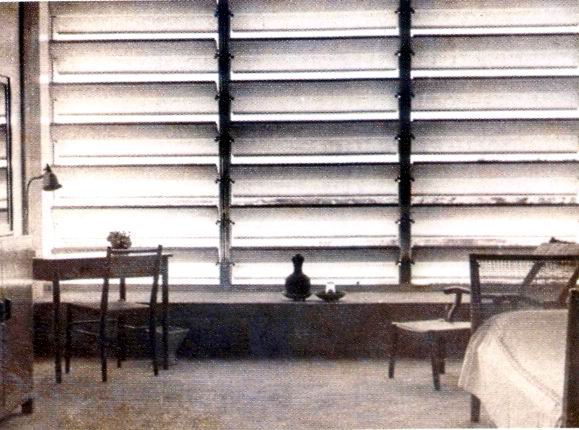
Golconde room interior, louvres closed |
Page - 27
|
Times were different. Attitudes were different. Means were less but
meanings were more. The sadhaks therefore achieved much with very
little. Their assets were faith, devotion and persistence or perseverance...
They, whether engineer or plain worker, poured not only their sweat but
also their heart-felt love into the job. They took great pride and derived
greater joy working. They could, after long years, say with the same pride
and joy: "I was there."
- Prabhakar -
All this reminds us that Golconde was conceived as a dormitory for
sadhaks - and for sadhaks of an Integral Yoga; forty individuals who
would be willing to put reverence for the divine consciousness in matter
into the smallest details of their daily life. Clearly, to live amid these
surroundings is at once a privilege and an education. Most of us are not
yet ready for that; but to all who value beauty and order in daily living,
and who sense the consciousness in material things, Golconde remains a
lasting inspiration.
- Shraddhavan - |
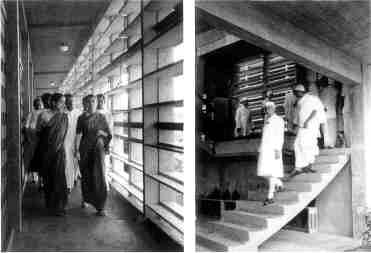
Indira Gandhi visit to Golconde Nov. 1955
Jawaharlal Nerhu visit to Golconde 18th Jan. 1955 |
|
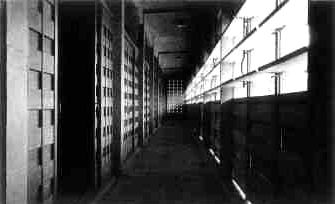
Golconde inside corridor - 1948 |
The Mother said: "Golconde is not a guest house. It is a dormitory (dortoir) in
which those who reside there can meditate and do their sadhana in beautiful
surroundings, in very fine rooms and with many of the little daily jobs done
for them, to keep them more free for their sadhana... In the old days, the
Rishis used to live in the mountains and their disciples lived in caves in these
mountains. Golconde is the modern equivalent of the caves for the integral yoga
of Sri Aurobindo."
- Udar - |
Page - 28
|
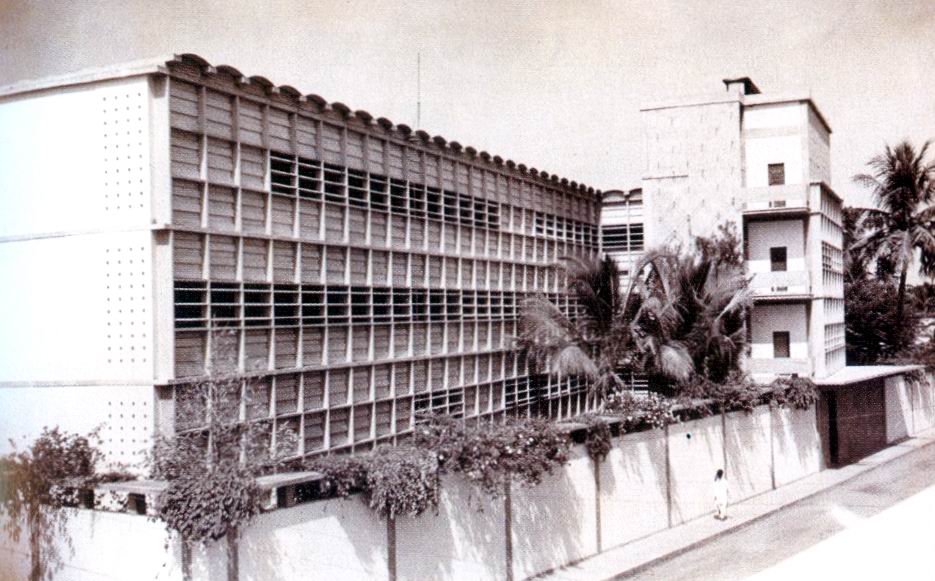
Golconde - 1948 |
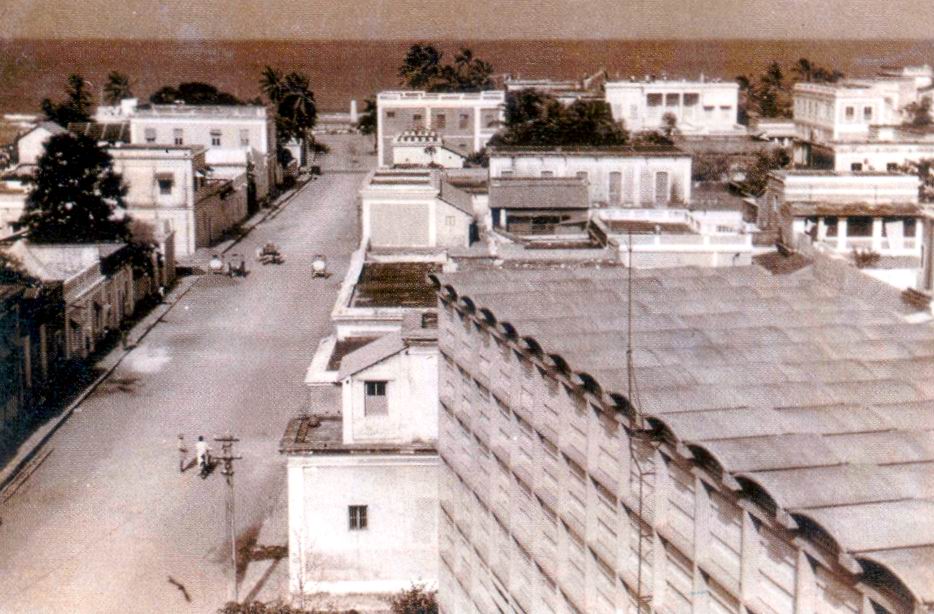
Early 40s - View of a street and one of lightning conductors
with the Bay of Bengal at the back |
NIGHT PATROL

|
In the evening of August 15th, 1947 when the whole of India was celebrating her Independence, the Ashram was attacked by a violent mob, instigated by a local political party. A disciple, Mulshankar, was fatally stabbed. For a few days after this tragic incident, the Ashram was put on a state of alert.
Guidelines were put up on the Ashram Notice Board regarding our code of conduct during those tense times. Always to be calm, never to get excited, to
behave in a dignified manner, to remain within the Ashram area and to have a companion while going anywhere; always to be conscious and be specially
alert while turning a corner, etc.
Every night male inmates of the Ashram were posted in strategic areas around the Ashram to observe and report on the hostile activities, if any, and to
guard the various Departments. Udar and Pranab went patrolling in Millie's famous Jeep (the old war horse is still giving service in Gloria Land), moving
from check-post to check-post.
-Aniruddha-
|
Page - 29 |

